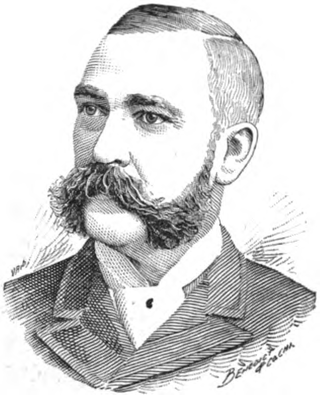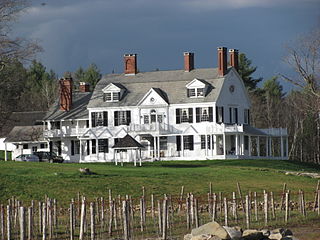Related Research Articles

Upper Arlington is a city in Franklin County, Ohio, United States, on the northwest side of the Columbus metropolitan area. As of the 2020 census, the population was 36,800. The Old Arlington neighborhood is listed on the National Register of Historic Places.

Mount Vernon is an American landmark and former plantation of Founding Father, commander of the Continental Army in the Revolutionary War, and the first president of the United States George Washington and his wife, Martha. The estate is on the banks of the Potomac River in Fairfax County, Virginia. It is located south of Washington, D.C., and Alexandria, Virginia, and is across the river from Prince George's County, Maryland.

Mentmore Towers, historically known simply as "Mentmore", is a 19th-century English country house built between 1852 and 1854 for the Rothschild family in the village of Mentmore in Buckinghamshire. Sir Joseph Paxton and his son-in-law, George Henry Stokes, designed the building in the 19th-century revival of late 16th and early 17th-century Elizabethan and Jacobean styles called Jacobethan. The house was designed for the banker and collector of fine art Baron Mayer de Rothschild as a country home, and as a display case for his collection of fine art. The mansion has been described as one of the greatest houses of the Victorian era. Mentmore was inherited by Hannah Primrose, Countess of Rosebery, née Rothschild, and owned by her descendants, the Earls of Rosebery.

Woodmont is a mansion and hilltop estate of 72 acres (29 ha) in Gladwyne, a suburb of Philadelphia, Pennsylvania, United States. In 1953, it became the home of evangelist Father Divine, and the center of his International Peace Mission movement. It was declared a National Historic Landmark in 1998 for its well-preserved Chateau-style architecture, and for its association with Father Divine.

Ohio Columbus Barber was an American businessman, industrialist and philanthropist. He was called "America's Match King" because of his controlling interest in the Diamond Match Company, which had 85 percent of the market in 1881. He founded the city of Barberton, Ohio in 1891 and moved his manufacturing plant there in 1894. It produced 250 million matches per day. He also founded the Akron City Hospital.

Arlington House is the historic family residence of Robert E. Lee, commander of the Confederate Army, and a national memorial in his honor serving as a museum, located in Arlington, Virginia. It is situated in the middle of Arlington National Cemetery, overlooking the Potomac River and the National Mall.

George Washington Parke Custis was an American plantation owner, antiquarian, author, and playwright. His father John Parke Custis was the stepson of George Washington. He and his sister Eleanor grew up at Mount Vernon and in the Washington presidential household.

Hoghton Tower is a fortified manor house two-thirds of a mile (1 km) east of the village of Hoghton, Lancashire, England, and standing on a hilltop site on the highest point in the area. It takes its name from the de Hoghton family, its historical owners since at least the 12th century. The present house dates from about 1560–65.

George N. Saegmuller was a German-born American inventor of many astronomical instruments and other mechanical devices.

Located south of Laurel in Prince George's County, Maryland, United States, Montpelier Mansion is a five-part, Georgian style plantation house most likely constructed between 1781 and 1785. It has also been known as the Snowden-Long House, New Birmingham, or simply Montpelier. Built by Major Thomas Snowden and his wife Anne, the house is now a National Historic Landmark operated as a house museum. The home and 70 acres (28 ha) remain of what was once a slave plantation of about 9,000 acres (3,600 ha).

Cherry Grove, located on property formerly called Fredericksburg, 400 acres patented by Orlando Griffith's oldest son Henry Griffith in 1750. Cherry Grove is a historic home and former plantation located at Woodbine, Howard County, Maryland, United States. The home is considered the seat of the Warfield family of Maryland.

Waverly Mansion is a historic home located at Marriottsville in Howard County, Maryland, USA. It was built circa 1756, and is a 2+1⁄2-story Federal style stone house, covered with stucco, with a hyphen and addition that date to circa 1811. Also on the property are a small 1+1⁄2-story stone overseer's cottage and a 2-story frame-and-stone barn, and the ruins of a log slave quarter.

The John A. Green Estate is a historic property in Stone City, Iowa, United States. The estate covers 200 acres (0.81 km2) of land. The buildings were constructed of Anamosa Limestone quarried from John Green's own local business. The estate was individually listed as a historic district on the U.S. National Register of Historic Places in 1978. It was included as a contributing property in the Stone City Historic District in 2008.

Brook Farm is a historic country estate farm at 4203 Twenty Mile Stream Road in Cavendish, Vermont. It includes one of the state's grandest Colonial Revival mansion houses, and surviving outbuildings of a model farm of the turn of the 20th century. It was listed on the National Register of Historic Places in 1993. The property is now home to the Brook Farm Vineyard.

The Cameron Estate was one of the five summer homes of Simon Cameron, President Lincoln's Secretary of War, and his family from 1872 to 1959. The Estate is in Lancaster County, Pennsylvania, and is often referred to as "Donegal" by the Camerons.

Minor's Hill is a geographic eminence located in the western tip of Arlington County, Virginia. Its summit rises to 459 feet above sea level which makes it the highest point in the county. The hill is named after a man named George Minor who lived there at the time of the American Revolutionary War.

Dolobran is a Shingle Style house at 231 Laurel Lane in Haverford, Pennsylvania. It was designed by architect Frank Furness for shipping magnate Clement Griscom in 1881, and was expanded at least twice by Furness. The house and 146-acre estate served as a summer retreat for Griscom, his wife, and five children.

Miles Ranch near Dawson, Nebraska was the first of the great ranches established west of the Missouri River. It was established by Stephen Boyd Miles in 1855 as part of “mail grant land” awarded by the United States Government in exchange for transporting mail, freight, and passengers between Independence, Missouri, and Salt Lake City, Utah. Strategically located along the Overland Trail, the Ranch became the headquarters of Miles’ stage line empire. Hundreds of horses and mules were recuperated at the Ranch to service the thriving stage line business. Hemp was the first crop and used to make rope.

Fatland – also known as "Fatland Farm," "Fatland Ford" and, currently, "Vaux Hill" – is a Greek Revival mansion and estate in Audubon, Pennsylvania. Located on the north side of the Schuylkill River, opposite Valley Forge, the property was part of the Continental Army's 1777-78 winter encampment. On consecutive days in September 1777, its stone farmhouse served as headquarters for General George Washington and British General Sir William Howe.
References
- 1 2 3 4 5 6 7 8 National Register of Historic Places Registration Form, United States Department of the Interior: National Park Service
- 1 2 3 4 5 Rosenberg, Madelyn, "Full House", Arlington Magazine
- ↑ Vincent, Kevin. "George Nicholas Saegmuller". Historical Marker Database. Bernard Fisher. Retrieved 16 November 2014.
- 1 2 "George Nicholas Saegmuller, Inventor, Is Dead". The Evening Star. The Evening Star. 14 February 1934.
- ↑ White, John M., "EDW Stein", The EDW History Project
- ↑ J, A, "Saegmuller Barn", The EDW History Project